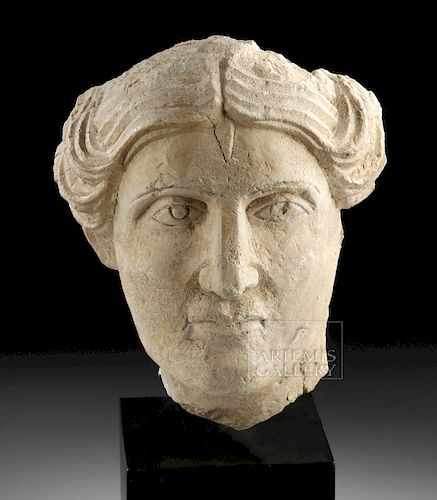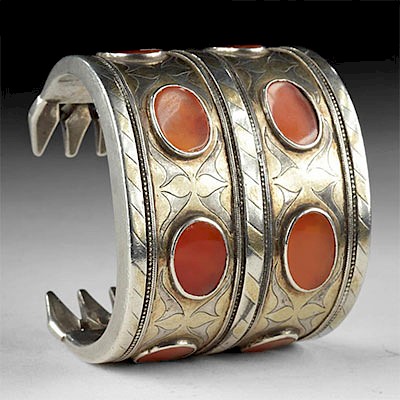Stunning Palymyran Limestone Head of a Woman
Lot 63
About Seller
Artemis Fine Arts
686 S Taylor Ave, Ste 106
Louisville, CO 80027
United States
Selling antiquities, ancient and ethnographic art online since 1993, Artemis Gallery specializes in Classical Antiquities (Egyptian, Greek, Roman, Near Eastern), Asian, Pre-Columbian, African / Tribal / Oceanographic art. Our extensive inventory includes pottery, stone, metal, wood, glass and textil...Read more
Estimate:
$8,000 - $12,000
Absentee vs Live bid
Two ways to bid:
- Leave a max absentee bid and the platform will bid on your behalf up to your maximum bid during the live auction.
- Bid live during the auction and your bids will be submitted real-time to the auctioneer.
Bid Increments
| Price | Bid Increment |
|---|---|
| $0 | $25 |
| $300 | $50 |
| $1,000 | $100 |
| $2,000 | $250 |
| $5,000 | $500 |
| $10,000 | $1,000 |
| $20,000 | $2,500 |
| $50,000 | $5,000 |
| $100,000 | $10,000 |
| $200,000 | $20,000 |
About Auction
By Artemis Fine Arts
Aug 6, 2019
Set Reminder
2019-08-06 11:00:00
2019-08-06 11:00:00
America/New_York
Bidsquare
Bidsquare : VARIETY SALE | Antiquities & Ethnographic Art
https://www.bidsquare.com/auctions/artemis-gallery/variety-sale-antiquities-ethnographic-art-4326
Around the world & back in time - be amazed at the treasures you will find. Antiquities from Egypt, Greece, Italy and the Near East, Asian, Pre-Columbian, African / Tribal / Oceanic, Native American, Spanish Colonial, Russian Icons, Fine Art, much more! All categories, all price ranges... Artemis Fine Arts info@artemisfinearts.com
Around the world & back in time - be amazed at the treasures you will find. Antiquities from Egypt, Greece, Italy and the Near East, Asian, Pre-Columbian, African / Tribal / Oceanic, Native American, Spanish Colonial, Russian Icons, Fine Art, much more! All categories, all price ranges... Artemis Fine Arts info@artemisfinearts.com
- Lot Description
Near East / Holy Land, Palmyra, Roman period, ca. 1st to 3rd century CE. A high relief head of beautiful woman, skillfully hand-carved from limestone and most likely a funerary portrait for an elaborate tomb of an elite family. Her visage is tranquil in demeanor with large almond-shaped eyes showing delineated irises and lids, a strong brow line, an aquiline nose, full lips that are closed to connote a solemn gaze, naturalistically rendered cheeks and chin, and a centrally parted wavy coiffure. Note that traces of black pigment outline the eyes, embellish the irises/pupils, and further delineate the brows. Originally it was covered in a thin white slip and then bright colors were applied. Lifelike portraits like this were intended to represent individuals. Although not truly veristic depictions, Palmyrene portraits still conveyed unique qualities of individuals. From busts like this, scholars are actively learning about family genealogies in Palmyrene society. Size: 4.5" L x 6.125" W x 7.75" H (11.4 cm x 15.6 cm x 19.7 cm); 12.25" H (31.1 cm) on included custom stand.
Palmyra was a wealthy city that linked the caravan routes from the Parthian Near East with the Roman Mediterranean; the people who lived there during this period largely enjoyed prosperity and were able to adopt eastern and western customs, clothing, and artistic styles, creating a distinctive visual culture unique to the city. We know of this culture today from the large funerary monuments that the Palmyrans built - tower-shaped vaults whose interiors were lined with sculpted limestone reliefs depicting the deceased.
According to archaeologist Rubina Raja who is spearheading the Palmyra Portrait Project, "Originally they (busts like this) were put up as closing slabs in front of burial niches in the monumental tower tombs underground, and also in the so-called temple tombs. The busts would have been put up as closing slabs for burial niches. People would be mummified and put on shelves, and in front of that you would display the funerary portrait."
Provenance: private East Coast, USA collection; ex-Artemis Gallery; ex-private New Jersey, USA collection; ex-William Froelich collection, New York, USA, acquired in the 1970s
All items legal to buy/sell under U.S. Statute covering cultural patrimony Code 2600, CHAPTER 14, and are guaranteed to be as described or your money back.
A Certificate of Authenticity will accompany all winning bids.
We ship worldwide and handle all shipping in-house for your convenience.
#146948A large section from a funerary sculpture with losses to verso and peripheries as shown. Stress cracks to forehead, neck, and areas of coiffure. Expected surface wear with scuffs, pigment loss (though traces of black pigment remain on eyes and brows), and nicks. Restoration to nose and possibly areas of cheeks.Condition
- Shipping Info
-
All shipping is handled in-house for your convenience. Your invoice from Artemis Gallery will include shipping calculation instructions. If in doubt, please inquire BEFORE bidding for estimated shipping costs for individual items.
-
- Buyer's Premium



 EUR
EUR CAD
CAD AUD
AUD GBP
GBP MXN
MXN HKD
HKD CNY
CNY MYR
MYR SEK
SEK SGD
SGD CHF
CHF THB
THB














